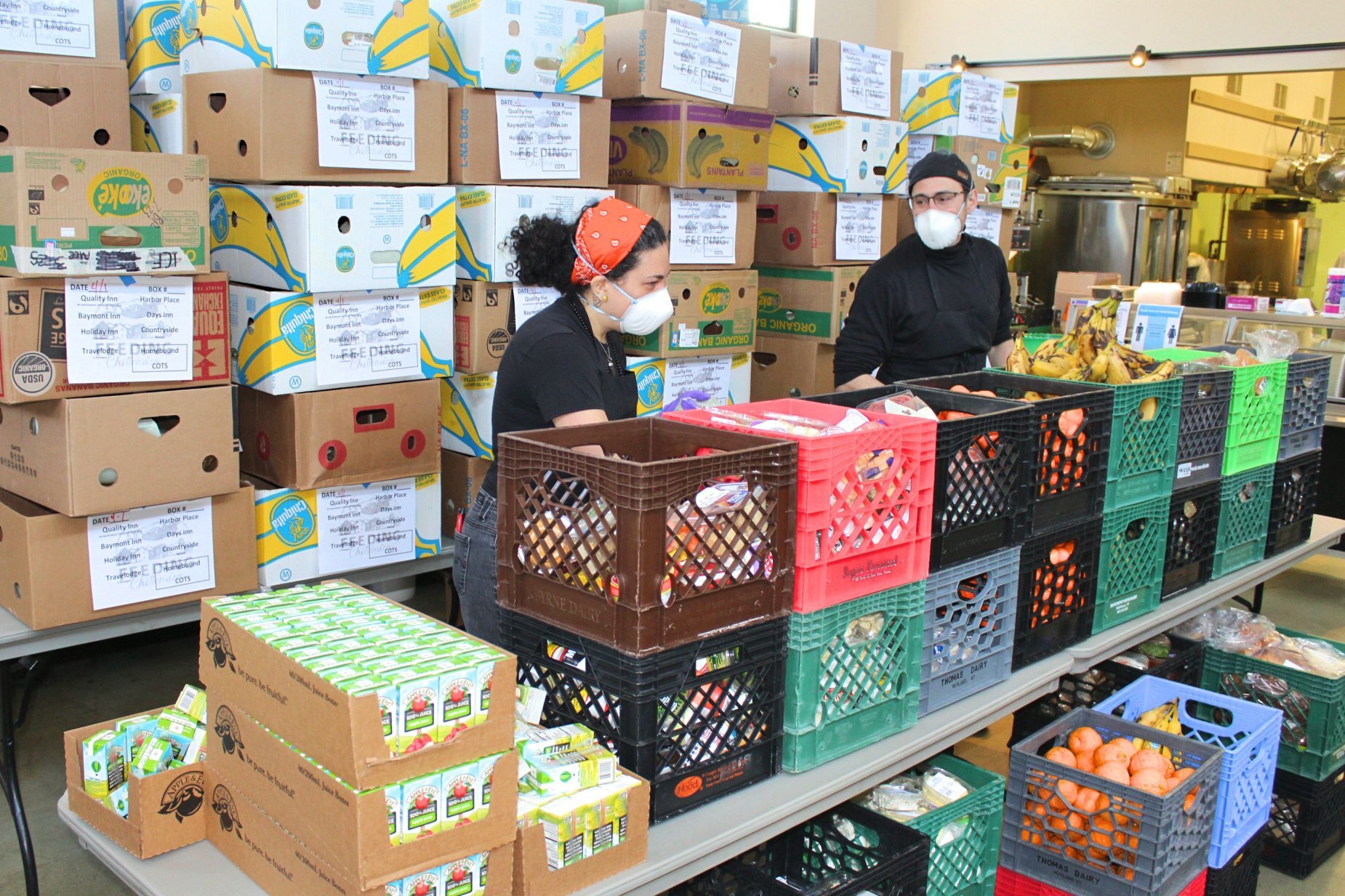Food shelves on the front lines of COVID-19 crisis
Janet Calcaterra and Thron Crowe, recent graduates of the Feeding Chittenden Community Kitchen Academy assist with the Emergency Meal Program. Photo by Anna McMahon.
As the COVID-19 pandemic forces many businesses to shut down temporarily or, in some cases, for good, more out-of-work Vermonters are turning to food shelves and food banks to help nourish themselves and their families.
Vermont Foodbank and its partner food shelves are busy shifting their operations to both adapt to social distancing measures and to meet the increasing need in their communities.
Nicole Whalen, Director of Communications and Public Affairs at Vermont Foodbank, described how the Foodbank and other food shelves “have been really on the front lines of addressing the huge increase in the need for food assistance that is coming as a result of this crisis.”
Vermont Foodbank is the nonprofit hunger relief organization that works with a network of more than 300 community partners to distribute food across the state. Those partners include Shelburne Food Shelf, Hinesburg Food Shelf, and Feeding Chittenden in Burlington.
Since the onset of the COVID-19 crisis and the closing of all non-essential businesses last month, Vermont Foodbank’s operations have seen 30 to 100% more patrons.
“This pandemic is creating a food assistance emergency unlike anything we’ve ever seen in the 40-year life of food banking,” Whalen said.
According to projections from Feeding America, this crisis could result in a 46% increase in the number of people experiencing food insecurity nationwide. Whalen said that could mean an increase of about 34,000 more Vermonters facing food insecurity, pushing the need to approximately 108,000, up from 74,500.
Whalen referenced two of their monthly VeggieVanGo events — one on Thursday, March 19 at Northeast Vermont Regional Hospital in St. Johnsbury and another on Friday, March 20, at a school in Winooski. “Typically when we do that [hospital] event, we usually serve 200 people, and we saw 400.” As for the Winooski event, she said: “We usually serve 400 families and [we] served 650, so we’re seeing just really dramatic numbers.”
By April 6, the increase reached 98%, Whalen said, with 1,685 families served, up from a typical 849.
Volunteers who run local food shelves confirm this trend. Susan Stock is chair of the Shelburne Food Shelf board. “Our demand last time we had a distribution was up about 50%, and we anticipate that that’s going to continue,” she said.
Jeff Glover, co-director of the Hinesburg Food Shelf, said that in the first week of the state’s stay home order, five new families had come in.
Whalen explained that the current crisis is having a double impact: people who normally struggle with hunger are needing more help than ever before, and others are now seeking help for the first time.
On Monday, Whalen said the state of Vermont reported a six-fold increase in applications for 3SquaresVT (SNAP) benefits. Foodbank outreach staff between March 16 and April 8 assisted 152 people looking to sign up. They helped just 24 applicants in the same period in 2019.
Photo by Hannah Harrington.
Foodbank ramping up to support local food shelves
In response, the Foodbank is trying to purchase as many additional staple food items as possible to support their partner food shelves, said Whalen. March distribution — aided by two more leased trucks — was up by 370,000 pounds of food to stock local food shelves.
To meet the initial wave, the Foodbank spent an extra $75,000 to buy Vermont-grown produce. “We know that this crisis is impacting our farmers as well and we want to do what we can to support them while fighting hunger,” Whalen explained, adding that the Foodbank has budgeted to spend an additional $200,000 on local produce in the coming months.
The Foodbank is buying from farms such as Pitchfork Farm, Dwight Miller Farm, Laughing Child Farm, Intervale, Jericho Settlers, and Deep Root Organic Co-op, Whalen said, farms now struggling since restaurants and farmers markets have closed.
But central distribution alone won’t meet the need quickly enough. “We recognize there is some lag time before our bulk orders will arrive. To address this, we are providing a total of $195,000 in cash grants to 128 food shelves and 42 meal sites in our network,” Whalen said. “They can use these funds for emergency food and supply purchases, or whatever else they need to keep their doors open. These checks range from $150-$10,000 depending on how many people each site serves.”
Whalen said another role for the Foodbank is to consult with state emergency response officials to ensure that the needs of people facing hunger are met. Plans are underway, she said, to partner with community action agencies on a proposal for a mass feeding program.
Vermont’s network of donations and food distribution will likely see some federal support from relief legislation passed by Congress through the Emergency Food Assistance Program. “But it will take time for that food to reach us — likely not until June or July,” Whalen said. “And what is currently legislated will not come close to meeting the need, particularly given the timing and the restrictions on distribution.”
Virus precautions affect operations
“What’s extra crazy right now,” Whalen explained, is that the need is increasing as everyone involved in food distribution must adapt their operations to help prevent the spread of the virus.
Typically, food shelves follow a client choice model, allowing guests to come in, peruse the shelves, and choose what they want. Now, food shelf staff are pre-bagging and pre-boxing food for people to take, Whalen explained. “There’s a huge need for bags, boxes, and to-go containers for meals. And a huge need for the labor to pre-pack everything. That’s much more labor-intensive,” she said.
Food shelves are experimenting with different models. For example, the Shelburne Food Shelf started by using a drive-through process. “That worked OK, but we weren’t satisfied mostly with the safety that it offered our volunteers,” Stock said. “Our food shelf is incredibly small. It’s hard to get two people into the food shelf with them being six feet apart.”
Now the food shelf is encouraging pre-ordering and using delivery as much as possible to further protect volunteers.
Stock explained how the new process works: First, people fill out an online survey with their food preferences. Then, board members and their immediate families will go to the food shelf at different times to pack up the food orders to be delivered on the subsequent day.
Relying on family volunteer groups will help alleviate the need for six-foot distancing in the process, Stock explained.
Feeding Chittenden in Burlington is offering a mix of pick-up and delivery, according to Anna McMahon, Donor and Community Engagement Manager. On Monday, Wednesday, and Friday from 9 a.m. to 4 p.m., Feeding Chittenden distributes pre-boxed groceries at the door of their food pantry to over 800 people each week. They also have transitioned to a take-out dining service with their soup kitchen which feeds 60 people a day. Breakfast foods are packed up in to-go containers as well, McMahon said, and served Monday through Friday, 6:30 to 8:30 a.m.
“Our biggest undertaking right now is our meal delivery service,” McMahon added. The operation’s Emergency Meal Delivery program now “prepares and delivers over 1,000 meals daily to homeless and displaced individuals living in temporary shelters throughout Greater Burlington.”
Before the pandemic, Feeding Chittenden already ran a homebound delivery service, serving 150 households in the area. That number has since increased to 200 households, according to McMahon.
The food shelf is also receiving calls for emergency deliveries. McMahon explained that due to fear of the virus, “Folks that would normally come here to get food are now calling.” They are currently receiving about 10 to 20 emergency calls per day, and they expect that number to increase.
Glover at the Hinesburg Food Shelf laments the loss of community-building due to socially distanced pick-up and delivery methods.
The Hinesburg Food Shelf used to offer a very friendly set-up where people would enter and explore the food shelf with a volunteer, building rapport. Glover said. “The whole goal of that for many people was to take the shame out of coming to the food shelf. It allowed people to get to know each other,” he explained.
Now, given social distancing guidelines, people must pull up in their car and open the trunk. Volunteers place the pre-packed boxes of food in the car, close the trunk, and say farewell. “It’s very sterile now compared to the fun it was before,” Glover described.
The Hinesburg Food Shelf also will deliver to those who may have difficulty leaving their homes. “Anybody who calls up can have food delivered to them once a month,” Glover said.
Feeding Chittenden’s Distribution Coordinator Edi Abeneto checks out a food order. Photo by Anna McMahon.
Other challenges: Volunteers, variety
In addition to meeting a sharp increase in demand and adapting to public health guidelines, those running food assistance programs during the COVID-19 crisis may be struggling with a shortage of volunteers.
Glover at the Hinesburg Food Shelf said that many people who used to volunteer are older and now need to protect themselves from exposure to the virus. For example, the food shelf had 30 volunteers with six people per shift; now Glover is managing with only four people per shift, he said.
Given guidelines for people to stay physically apart, McMahon said Feeding Chittenden spreads out staff to only allow four people on site per day.
Creativity during a time of crisis
Despite the layers of challenges, Vermont Foodbank and its partner food shelves are persevering with high spirits.
Although she recognizes it at all times of the year, McMahon at Feeding Chittenden said this crisis is really “emphasizing the importance of this work” and the dedication of those doing it.
At the Vermont Foodbank, Whalen said the crisis creates an opportunity for the community to come together and help each other. “It’s been amazing to see the support and the willingness to step up and try and help their neighbor. There are so many creative ways that people are doing that,” Whalen said.
The Foodbank and the other operations all report an outpouring of support from the community, as individuals, businesses, and restaurants offer their help and donations.
Whalen pointed to a project with Skinny Pancake to make takeout meals and the Foodbank’s Community Kitchen Academy producing meals for people facing homelessness who are staying in motels.
As everyone in the food-assistance pipeline pushes to meet the new demands under difficult circumstances, they say their aim is to not leave anyone behind.
“The important message that we are trying to get out is that we are here for anyone who needs help,” emphasized Whalen. “We know that during this crazy time a lot of people who haven’t had to reach out before are finding themselves in challenging situations where they need help accessing food. And there is no shame in that and we want people to know that they are welcome.”
How to help
Food program officials suggest that those who are able to support the Foodbank and local food shelves consider online monetary donations.
McMahon from Feeding Chittenden explained that cash contributions are safe and help those running the operations to meet specific needs. “We can buy in bulk. [For example,] when more cleaning products or hand sanitizer becomes more available, we can purchase that first thing.”
Helpful links:









